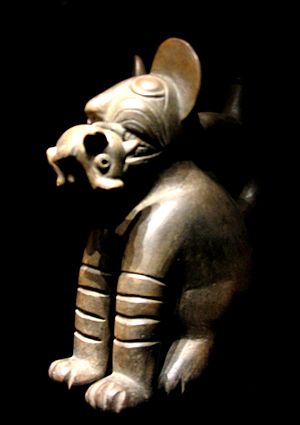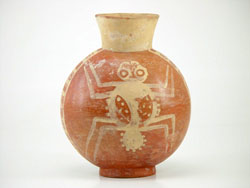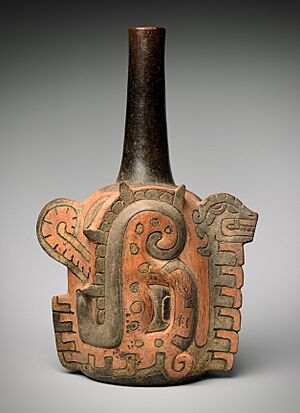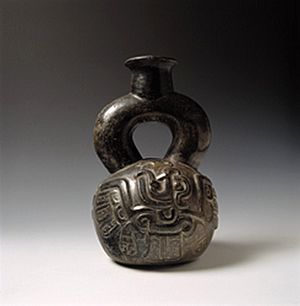Cupisnique facts for kids
The Cupisnique culture was an ancient civilization that lived in what is now northern Peru a very long time ago, from about 1500 BC to 500 BC. They were known for their unique buildings made from adobe clay. Their art and religious symbols were similar to those of the Chavin culture, which appeared later in the same area.
Contents
Cupisnique and the Chavin Culture

Scientists are still learning about how the Cupisnique and Chavin cultures were connected. Sometimes, people even use the names to mean the same thing! For example, some experts think the Cupisnique culture lasted from 1000 BC to 200 BC, which is also when some believe the Chavin culture existed. Other experts see the Cupisnique as a possible ancestor to the later Moche people.
Spider God Temple Discovered
In 2008, an ancient Cupisnique temple made of adobe was found in the Lambayeque valley, near a place called Ventarron. This new temple was very close to another important site known as Collud.
This temple was special because it had images of a spider god. This discovery helps us understand the link between the Cupisnique and Chavin cultures, as they shared similar symbols. Other related temples were also found nearby around the same time.
About 300 years after the Cupisnique built their temple, the Chavin people built their own temple next to Collud, in a spot called Zarpan. These three temples are all very close together, forming one big archaeological area.

Many symbols found at these three sites are similar. For example, the spider god is a common image. This spider symbol seems to have been important for a very long time, from the 4,000-year-old Ventarron temple all the way to the Moche culture around 300 AD.
The temple found in 2008 also featured the spider god. People believe this god was connected to rain, hunting, and even battles. The spider god image often combined a spider's head and neck with the mouth of a large cat and the beak of a bird.
Walter Alva, the leader of the discovery team, said that "Cupisnique and Chavin shared the same gods and the same architectural and artistic forms, showing intense religious interaction among the cultures of the Early Formative Period from the north coast to the Andes and down to the central Andes." This means they had similar beliefs and ways of building and creating art.
Cupisnique and the Moche Culture

Sometimes, the Moche and Cupisnique cultures are talked about as if they are the same. This is because their ceramic art designs are very similar. The Moche were a lively culture that grew out of the Cupisnique society. The Cupisnique society included farmers, fishers, and also had middle and upper classes.
A key connection between the Cupisnique and Moche is a shared theme in their art: images of figures performing symbolic acts of separation or transformation. In Cupisnique art, these figures appeared as humans, monsters, birds, fish, and spiders. Moche art included these five, plus crabs and scorpions.
Experts believe these similarities are not just a coincidence. They think the Moche people continued the beliefs and practices of the Cupisnique.
Some people have called the Cupisnique people a "cult" because there wasn't much clear information about how their society was organized, how many people lived there, or how they got their food. Also, their buildings were decorated with painted and carved designs showing strange, dream-like creatures.
The symbols and art of the Cupisnique seem to have been deeply connected to their religion. This religion likely had a big influence on later cultures that developed in the area, such as the Salinar, Vicus, Gallinazo, and especially the Moche culture.
Other Cupisnique Sites
One very important Cupisnique site is Caballo Muerto in the Moche Valley.
In 2008, archaeologists announced they had dug up another Cupisnique site called Limoncarro. This site is in the Guadalupe District, Pacasmayo, in the La Libertad Region on Peru's northern coast. They found two different building periods there, and uncovered animal faces that showed Cupisnique art styles.
Kuntur Wasi is another ancient site that was influenced by the Cupisnique culture.
In 2020, farmers clearing land in the La Libertad region of northwestern Peru found the remains of a shrine. It had a large mural painted in shades of red-brown, yellow, gray, and white. This site was unknown before. Sadly, about 60% of the shrine was accidentally destroyed during the clearing. Researchers have identified the mural as a 3,200-year-old painting of a spider god holding a knife.
Cupisnique Mirrors
Mirrors from 900-200 BC have been found at Cupisnique archaeological sites. These mirrors were made with such skill that they could reflect clear images.
Images for kids
See also
 In Spanish: Cultura cupisnique para niños
In Spanish: Cultura cupisnique para niños





